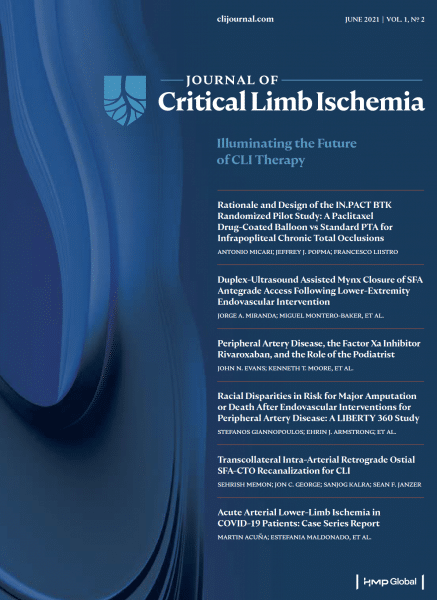Outcomes of Orbital Atherectomy in Patients With Critical Limb Threatening Ischemia and Diabetes
Momodou L. Jammeh, MD1; Julia Suggs, MD1; George L. Adams, MD, MHS2;
Ehrin J. Armstrong, MD3; Jihad A. Mustapha, MD4; Mohamed A. Zayed, MD, PhD1,5,6,7
Abstract

Purpose
Patients with diabetes and critical limb threatening ischemia (CLTI) are at significantly higher risk of limb loss and death. We evaluate the outcomes of orbital atherectomy (OA) for the treatment of CLTI in patients with and without diabetes.
Methods
A retrospective analysis of the LIBERTY 360 study was performed to evaluate baseline demographics and periprocedural outcomes between patients with CLTI, and with and without diabetes. Hazard ratios (HRs) were determined with Cox regression to examine the impact of OA in patients with diabetes and CLTI over a 3-year follow-up.
Results
A total of 289 patients (201 with diabetes, 88 without diabetes) with Rutherford classification 4-6 were included. Patients with diabetes had a higher proportion of renal disease (48.3% vs 28.4%; P<.01), prior minor/major limb amputation (26% vs 8%; P<.01), and presence of wounds (63.2% vs 48.9%; P=.03). Operative times, radiation dosages, and contrast volumes were similar between groups. The rate of distal embolization was higher in patients with diabetes (7.8% vs 1.9%; P=.01; odds ratio, 4.33; 95% confidence interval, 0.99-18.88; P=.05). However, at 3 years post procedure, patients with diabetes had no differences in freedom from target-vessel/target-lesion revascularization (HR, 1.09; P=.73), major adverse events (HR, 1.25; P=.36), major target-limb amputation (HR, 1.74; P=.39), and death (HR, 1.11; P=.72).
Conclusion
The LIBERTY 360 study observed high limb preservation and low major adverse events in patients with diabetes and CLTI. Higher distal embolization was observed with OA in patients with diabetes, but the odds ratio did not indicate a significant difference in risk between groups.
Disclosures
1Department of Surgery, Section of Vascular Surgery, Washington University School of Medicine, St Louis, Missouri;
2University of North Carolina at Chapel Hill Rex Health Care System, Raleigh, North Carolina;
3Adventist Health and Vascular Institute at Adventist Health, St Helena, California;
4Advanced Cardiac & Vascular Centers for Amputation Prevention, Grand Rapids, Michigan;
5Washington University School of Medicine, Division of Molecular Cell Biology, St Louis, Missouri;
6Washington University, McKelvey School of Engineering, Department of Biomedical Engineering, St Louis, Missouri;
7Veterans Affairs St Louis Health Care System, St Louis, Missouri.
The Journal of CLI is the official publication of the CLI Global Society and a complimentary benefit for members. Read this full article at clijournal.com.
